The AMD Radeon R9 290X Review
by Ryan Smith on October 24, 2013 12:01 AM EST- Posted in
- GPUs
- AMD
- Radeon
- Hawaii
- Radeon 200
Compute
Jumping into pure compute performance, we’re going to have several new factors influencing the 290X as compared to the 280X. On the front end 290X/Hawaii has those 8 ACEs versus 280X/Tahiti’s 2 ACEs, potentially allowing 290X to queue up a lot more work and to keep itself better fed as a result; though in practice we don’t expect most workloads to be able to put the additional ACEs to good use at the moment. Meanwhile on the back end 290X has that 11% memory bandwidth boost and the 33% increase in L2 cache, which in compute workloads can be largely dedicated to said computational work. On the other hand 290X takes a hit to its double precision floating point (FP64) rate versus 280X, so in double precision scenarios it’s certainly going to enter with a larger handicap.
As always we'll start with our DirectCompute game example, Civilization V, which uses DirectCompute to decompress textures on the fly. Civ V includes a sub-benchmark that exclusively tests the speed of their texture decompression algorithm by repeatedly decompressing the textures required for one of the game’s leader scenes. While DirectCompute is used in many games, this is one of the only games with a benchmark that can isolate the use of DirectCompute and its resulting performance.
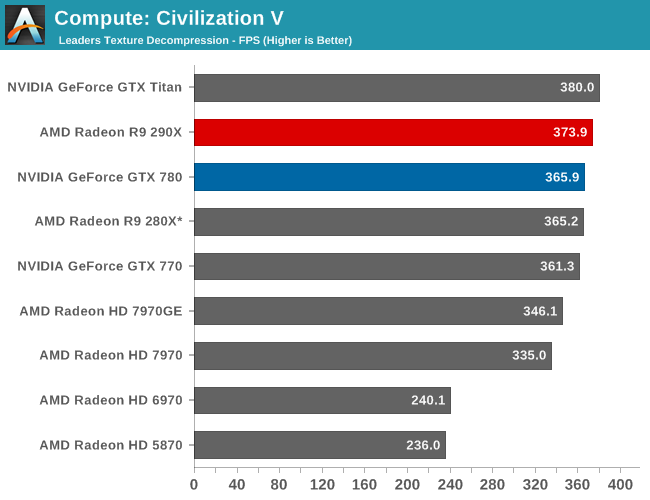
Unfortunately Civ V can’t tell us much of value, due to the fact that we’re running into CPU bottlenecks, not to mention increasingly absurd frame rates. In the 3 years since this game was released high-end CPUs are around 20% faster per core, whereas GPUs are easily 150% faster (if not more). As such the GPU portion of texture decoding has apparently started outpacing the CPU portion, though this is still an enlightening benchmark for anything less than a high-end video card.
For what it is worth, the 290X can edge out the GTX 780 here, only to fall to GTX Titan. But in these CPU limited scenarios the behavior at the very top can be increasingly inconsistent.
Our next benchmark is LuxMark2.0, the official benchmark of SmallLuxGPU 2.0. SmallLuxGPU is an OpenCL accelerated ray tracer that is part of the larger LuxRender suite. Ray tracing has become a stronghold for GPUs in recent years as ray tracing maps well to GPU pipelines, allowing artists to render scenes much more quickly than with CPUs alone.
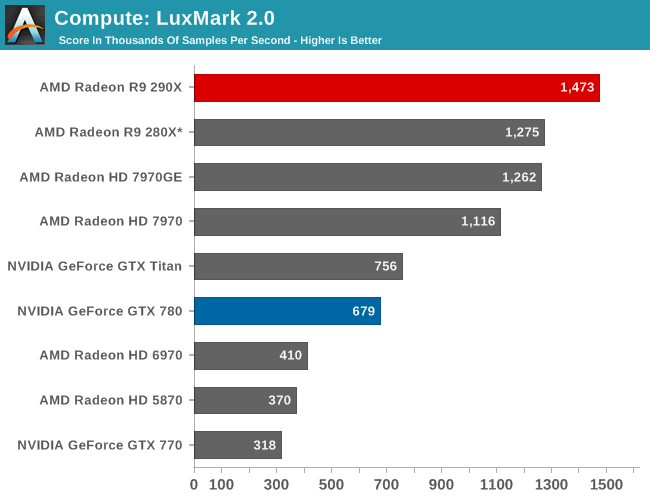
LuxMark by comparison is very simple and very scalable. 290X packs with it a significant increase in computational resources, so 290X picks up from where 280X left off and tops the chart for AMD once more. Titan is barely half as fast here, and GTX 780 falls back even further. Though the fact that scaling from the 280X to 290X is only 16% – a bit less than half of the increase in CUs – is surprising at first glance. Even with the relatively simplistic nature of the benchmark, it has shown signs in the past of craving memory bandwidth and certainly this seems to be one of those times. Feeding those CUs with new rays takes everything the 320GB/sec memory bus of the 290X can deliver, putting a cap on performance gains versus the 280X.
Our 3rd compute benchmark is Sony Vegas Pro 12, an OpenGL and OpenCL video editing and authoring package. Vegas can use GPUs in a few different ways, the primary uses being to accelerate the video effects and compositing process itself, and in the video encoding step. With video encoding being increasingly offloaded to dedicated DSPs these days we’re focusing on the editing and compositing process, rendering to a low CPU overhead format (XDCAM EX). This specific test comes from Sony, and measures how long it takes to render a video.
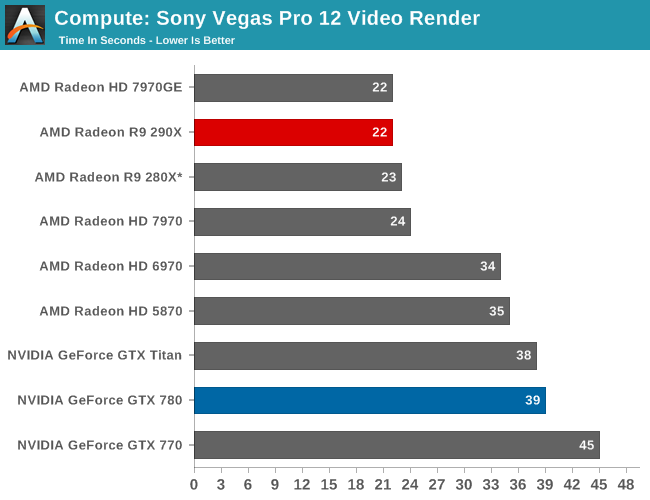
Vegas is another title where GPU performance gains are outpacing CPU performance gains, and as such earlier GPU offloading work has reached its limits and led to the program once again being CPU limited. It’s a shame GPUs have historically underdelivered on video encoding (as opposed to video rendering), as wringing significantly more out of Vegas will require getting rid of the next great CPU bottleneck.
Our 4th benchmark set comes from CLBenchmark 1.1. CLBenchmark contains a number of subtests; we’re focusing on the most practical of them, the computer vision test and the fluid simulation test. The former being a useful proxy for computer imaging tasks where systems are required to parse images and identify features (e.g. humans), while fluid simulations are common in professional graphics work and games alike.
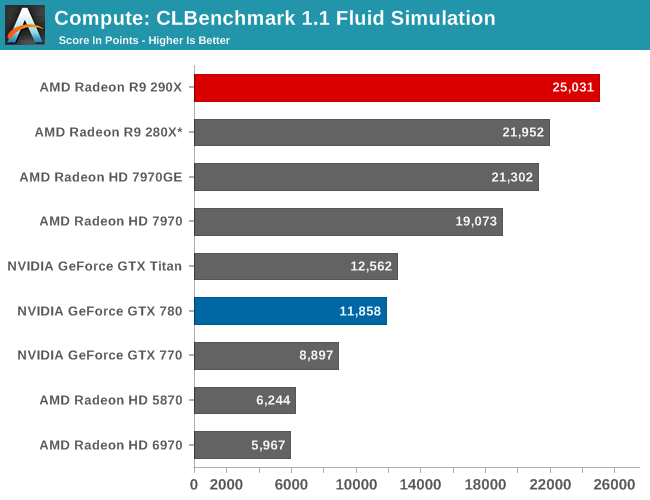
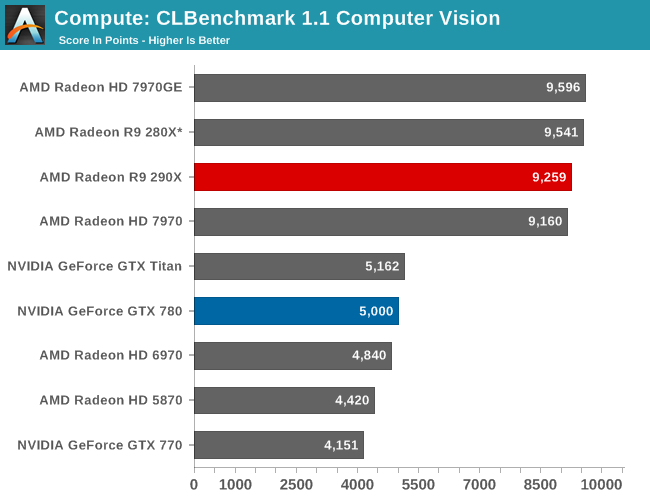
Curiously, the 290X’s performance advantage over 280X is unusual dependent on the specific sub-test. The fluid simulation scales decently enough with the additional CUs, but the computer vision benchmark is stuck in the mud as compared to the 280X. The fluid simulation is certainly closer than the vision benchmark towards being the type of stupidly parallel workload GPUs excel at, though that doesn’t fully explain the lack of scaling in computer vision. If nothing else it’s a good reminder of why professional compute workloads are typically profiled and optimized against specific target hardware, as it reduces these kinds of outcomes in complex, interconnected workloads.
Moving on, our 5th compute benchmark is FAHBench, the official Folding @ Home benchmark. Folding @ Home is the popular Stanford-backed research and distributed computing initiative that has work distributed to millions of volunteer computers over the internet, each of which is responsible for a tiny slice of a protein folding simulation. FAHBench can test both single precision and double precision floating point performance, with single precision being the most useful metric for most consumer cards due to their low double precision performance. Each precision has two modes, explicit and implicit, the difference being whether water atoms are included in the simulation, which adds quite a bit of work and overhead. This is another OpenCL test, as Folding @ Home has moved exclusively to OpenCL this year with FAHCore 17.
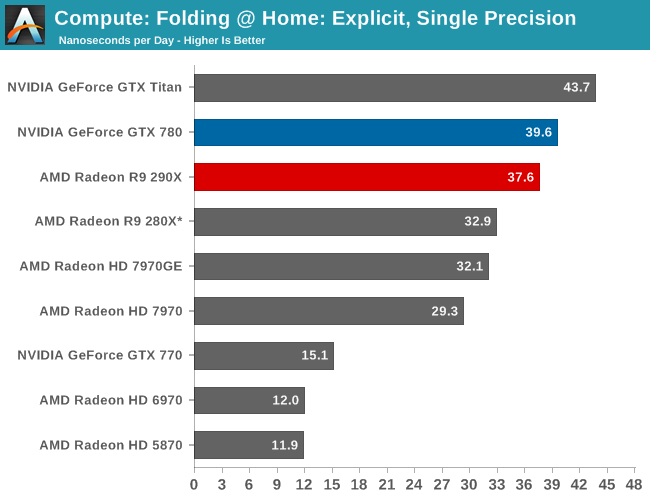
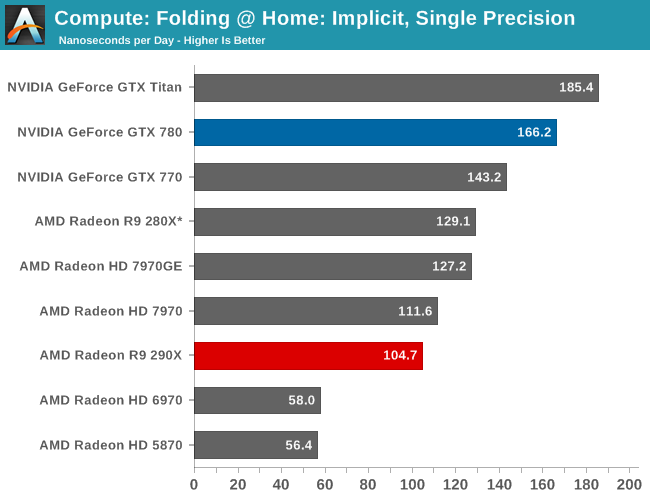

With FAHBench we’re not fully convinced that it knows how to best handle 290X/Hawaii as opposed to 280X/Tahiti. The scaling in single precision explicit is fairly good, but the performance regression in the water-free (and generally more GPU-limited) implicit simulation is unexpected. Consequently while the results are accurate for FAHCore 17, it’s hopefully something AMD and/or the FAH project can work out now that 290X has been released.
Meanwhile double precision performance also regresses, though here we have a good idea why. With DP performance on 290X being 1/8 FP32 as opposed to ¼ on 280X, this is a benchmark 290X can’t win. Though given the theoretical performance differences we should be expecting between the two video cards – 290X should have about 70% of the FP 64 performance of 280X – the fact that 290X is at 82% bodes well for AMD’s newest GPU. However there’s no getting around the fact that the 290X loses to GTX 780 here even though the GTX 780 is even more harshly capped, which given AMD’s traditional strength in OpenCL compute performance is going to be a let-down.
Wrapping things up, our final compute benchmark is an in-house project developed by our very own Dr. Ian Cutress. SystemCompute is our first C++ AMP benchmark, utilizing Microsoft’s simple C++ extensions to allow the easy use of GPU computing in C++ programs. SystemCompute in turn is a collection of benchmarks for several different fundamental compute algorithms, as described in this previous article, with the final score represented in points. DirectCompute is the compute backend for C++ AMP on Windows, so this forms our other DirectCompute test.
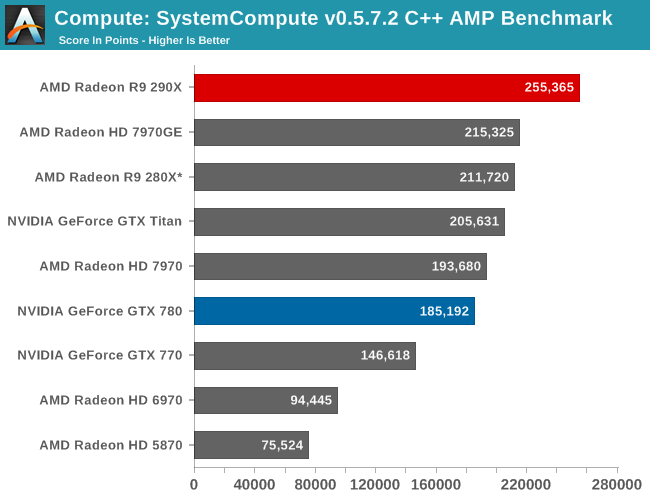
SystemCompute and the underlying C++ AMP environment scales relatively well with the additional CUs offered by 290X. Not only does the 290X easily surpass the GTX Titan and GTX 780 here, but it does so while also beating the 280X by 18%. Or to use AMD’s older GPUs as a point of comparison, we’re up to a 3.4x improvement over 5870, well above the improvement in CU density alone and another reminder of how AMD has really turned things around on the GPU compute side with GCN.










396 Comments
View All Comments
SolMiester - Monday, October 28, 2013 - link
So you can OC a 780 on stock, but not the 290x to sustain the OC, which means 780 wins!, especially after the price drop to $500!, oh dear AMD 290x just went from hero to zero...TheJian - Friday, October 25, 2013 - link
I gave links and named the games previously...See my post. At 1080p 780 trades blows depending on the games. Considering 98.75% of us are 1920x1200 or less, that is important and you get 3 AAA games with 780, on top of the fact that it's using far less watts, less noise and less heat. A simple drop in price of $50-100 and 780 seems like a no brainer to me (disregarding the 780TI which should keep the same price as now I'd guess). Granted Titan needs a dunk in price now too, which I'm sure will come or they'll just replace it with a full SMX up-clocked titan to keep that price. I'm guessing old titan just died as 780TI will likely beat it in nearly everything if the rumored clock speed and extra smx are true. They will have to release a new titan ULTRA or something with another smx or up the mhz to 1ghz or something. OR hopefully BOTH.I'm guessing it's easier to just up the 100mhz or put it to 1ghz as surely manufacturing has gotten them to where all will do this now, more than having all SMX's defect free. Then again if you have a bad SMX just turn a few more off and it's a 780TI anyway. They've had 8 months to either pile up cherry picked ones, or just improve totally anyway so more can do this easily. Clearly 780ti was just waiting in the wings already. They were just waiting to see 290x perf and estimates.
eddieveenstra - Sunday, October 27, 2013 - link
Titan died when 780gtx entered the room at 600 Euro. I'm betting Nvidia only brings a 780gtx ti and that's it. Titan goes EOL.anubis44 - Thursday, October 24, 2013 - link
This is the reference card. It's not loud unless you set it to 'Uber' mode, and even then, HardOCP thought the max fan speed should be set to 100% rather than 55%. Imagine how quiet an Asus Direct CUIII or Gigabyte Windforce or Sapphire Toxic custom cooled R9 290x will be.Crossfire and frame pacing all working, and R9 290X crushes Titan in 4K gaming (read HardOCP's review of this 4K section), all while costing $100 less than GTX780, and the R9 280X (7970) is priced at $299, and the R9 270X (7870) is now going for $180, and now Mantle API could be the next 3dfx Glide, and boost all 7000-series cards and higher dramatically for free...
It's like AMD just pulled out a light sabre and cut nVidia right in half while Jsen Hsun just stares dumbly at them in disbelief. He should have merged nVidia with AMD when he had the chance. Could be too late now.
Shark321 - Thursday, October 24, 2013 - link
There will be no custom cooling solution for the time being. It's the loudest card ever released. Twice as loud as 780/Titan in BF3 after 10 minutes of playing. Also Nvidia will bringt the 780Ti in 3 weeks, a faster cart at a comparable price, but quiet. AMD releases the 290x one year after NVidia, 2 years after NVidias tipeout. Nvidia will be able to counter this with a wink.just4U - Thursday, October 24, 2013 - link
Shark Writes: "It's the loudest card ever released."Guess you weren't around for the Geforce5...
HisDivineOrder - Thursday, October 24, 2013 - link
The FX5800 is not ever dead. Not if we remember the shrill sound of its fans......or if the sound burned itself into our brains for all time.
Samus - Friday, October 25, 2013 - link
I think the 65nm GeForce 280 takes the cake for loudest card ever made. It was the first card with a blower.ninjaquick - Thursday, October 24, 2013 - link
lol, the Ti can only do so much, there is no smaller node for either company to jump to, not until March for enough shipments to have stock for sales. The 290X just proves AMD's GCN design is a keeper. It is getting massively throttled by heat and still manages to pull a slight lead over the titan, at sometimes 15% lower clocks than reference. AMD needed a brand for this release season, and they have it.Both Nvidia and AMD are jumping to the next node in 2014. Nvidia will not release Maxwell on the current node. And there is no other node they would invest in going to.
HisDivineOrder - Thursday, October 24, 2013 - link
The Ti could theoretically open up all the disabled parts of the current GK110 part. Doing that, who knows what might happen? We've yet to see a fully enabled GK110. I suspect that might eat away some of the Titan's efficiency advantage, though.